
Biosecurity is becoming more important as we contend with the high number of invasive alien species that are being found in South Africa. SANBI, the South African National Biodiversity Institute, lists a total of 531 invasive species that must be controlled in South Africa. This list includes 381 plants, 40 mammals, 14 birds, 24 reptiles, 7 amphibians, 17 fresh-water fish, 23 terrestrial invertebrates, 8 fresh-water invertebrates, 13 marine invertebrates and 7 microbial species. What do you ask, has this got to do with grain farming?
Well, a lot actually, as the spread of agricultural pests is happening faster due to climate change, international commodity trading and the ‘global village’ phenomenon which are unavoidable realities of life in 2023. Information regarding potential problematic insect pests of wheat is thus presented in this article to inform producers so that a speedy response can be made should these insects be found in South Africa. The changing climate is already causing variations in the prevalence and occurrence of known wheat pests in South Africa, with more regular outbreaks of so-called sporadic pests being reported. Furthermore, based on the rate at which new pest incursions are increasing, scientists predict that crop-pest saturation could be a reality by 2050. In other words, all insect pests of a crop will be present throughout the world, wherever conditions are conducive for their survival.
Currently, amongst the many challenges facing wheat producers in South Africa, insect pests are not the primary concern. Those pests that occur in our small-grain production regions are known, as are the measures that can be taken to successfully control them. Climate change can alter this dramatically. Over the past few years, variations in the prevalence and occurrence of known wheat pests in South Africa have occurred. There have been more regular outbreaks of so-called sporadic pests, like the red-legged earth mite (Halotydeus destructor). Other serious pests such as the Russian wheat aphid (Diuraphis noxia) have receded and are no longer as prominent as they were in the past. These events highlight the need for pro-active awareness regarding the potential insect pests of wheat that may find their way to South Africa. Numerous species that are a concern in other parts of the world, do not yet occur in South Africa.
Knowing which pest insects could spread to South Africa from other wheat-producing areas of the world, is therefore advisable. Prior knowledge of these pests with respect to identification, damage caused, and potential control can mitigate widespread damage and promote a coordinated response from the wheat value chain. This article introduces five arthropod pests of wheat, known to cause substantial damage elsewhere in the world. They are wheat curl mite (Aceria tosichella Keifer), sunn pest (Eurygaster integriceps Puton), hessian fly (Mayetiola destructor Say), wheat stem saw fly (Cephus cinctus Norton) and orange wheat blossom midge (Sitodiplosis mosellana Géhin).
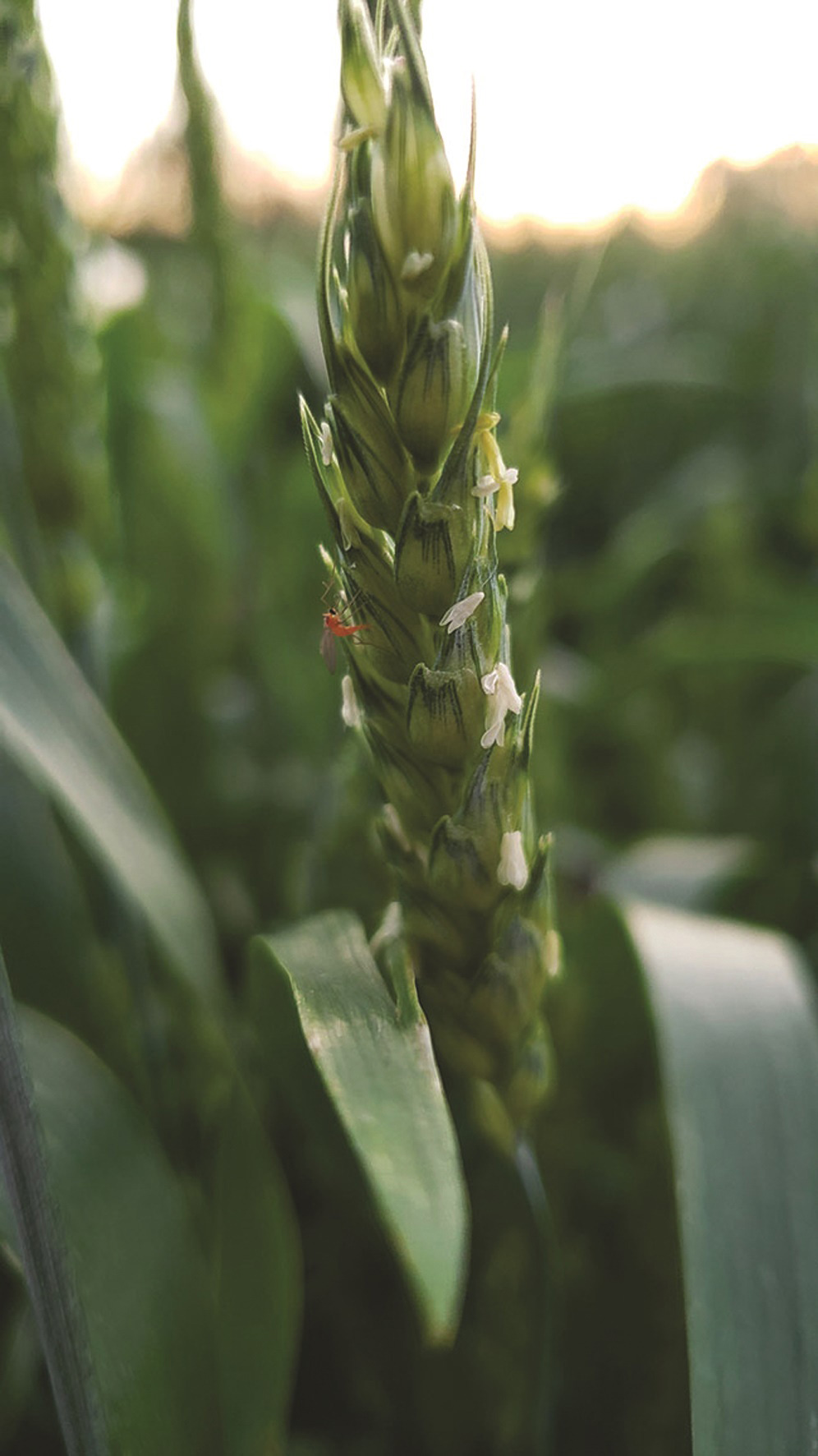
Photo: Tyler Wist
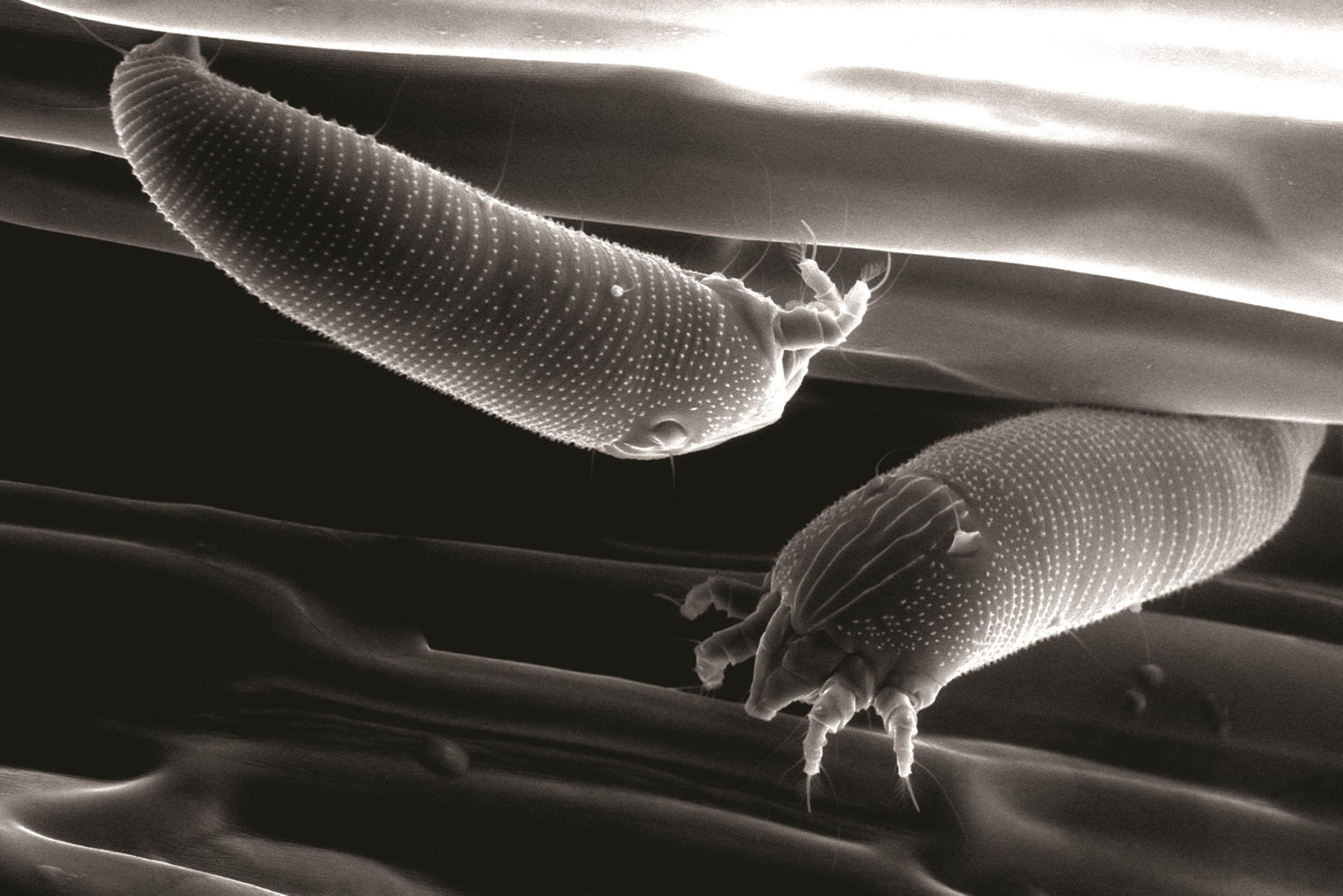
Photo: M-Schiffer, University of Melbourne
Wheat curl mite
These tiny eriophyid mites are important vectors of wheat streak mosaic virus (WSMV), which is one of the most destructive wheat diseases. Adult and immature wheat curl mites are tiny, white, cigar-shaped organisms with four legs near the head. They are practically invisible to the naked eye and fit between the veins of the wheat leaves. They lay their microscopically small eggs in rows along leaf veins. Most mites are found on the terminal leaves and move to each new leaf as it emerges. Heavy mite populations can cause the leaf margins to roll or curl inward, hence the name. As the wheat plant dries down, the wheat curl mites congregate on the flag leaves and even the glumes of the head where they are picked up by wind currents and carried to their over-summering grass hosts which include volunteer wheat, maize, and other wild grasses.
Destruction of volunteer wheat at least two weeks prior to planting wheat is the most effective management practice for this mite and the disease that it vectors.
Additionally, because this mite also occurs on maize, another potential problem is concerning. Where maize chlorotic mottle virus (MCMV) is present, double infections of MCMV and WSMV can occur. This combined infection gives rise to corn lethal necrosis disease. To date, neither wheat curl mite nor its main associated virus, WSMV, have been reported in South Africa
Sunn pest
This pest is actually a group of true bugs in the shield bug (Scutelleridae) and stink bug (Pentatomidae) families. Sunn pest is the most economically important insect pest of wheat and barley in the Middle and Near East, infesting over 15 million ha in southeast Turkey, Iran, Iraq, Syria, Lebanon, Jordan, Israel, Kazakhstan, Uzbekistan, Kyrgyzstan, Tajikistan, Afghanistan, and Pakistan. Yield loss occurs from nymphs and adults feeding directly on the plants. Besides this reduction in yield, an additional type of damage is caused when the insects inject salivary enzymes into the grain kernels to enhance predigestion. This enables them to avoid seed defensive chemicals such as digestive enzyme inhibitors and antifeedants.
Proteolytic and amylolytic enzymes in sunn pest saliva destroy the gluten in the grain and dramatically reduce the baking quality of the flour prepared from damaged grains. Grain damage as low as 2% or 3% is enough to make an entire lot of flour unacceptable for baking purposes. The bread prepared from the poor-quality flour burns quickly, fails to rise and has a bad flavour. A scientific study showed that South Africa is a highly suitable area for the occurrence of sunn pest, but that it may not become as widespread as initially thought, if climate change results in less rainfall and increased heat stress in our region. The estimated yield loss caused by high populations of sunn pest is 20% to 30% in barley and 50% to 90% in wheat.
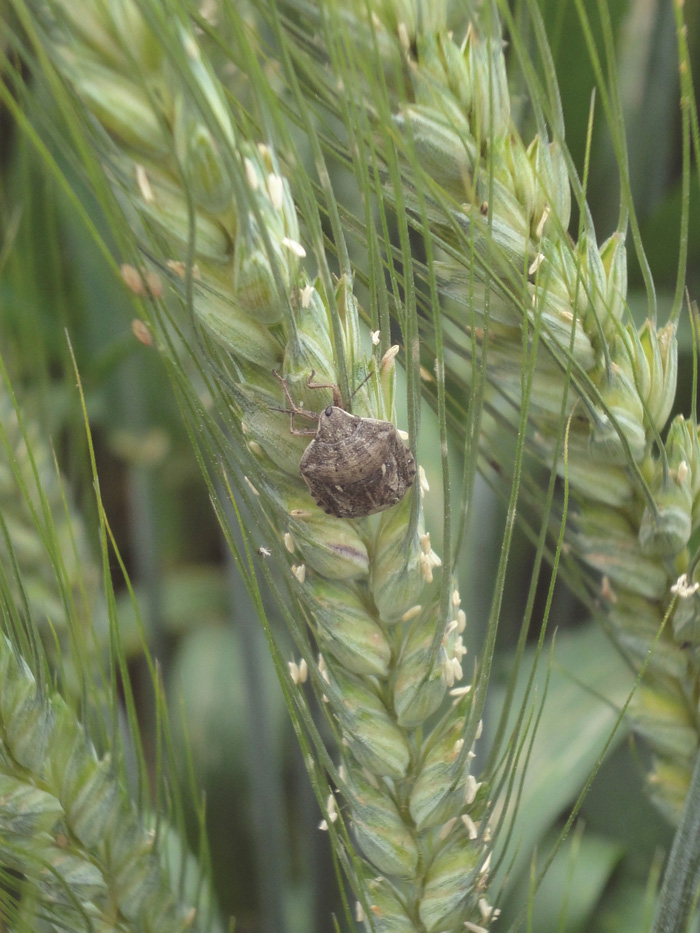
Photo: Dr Vicki Tolmay, ARC
Hessian fly
Hessian fly is a major pest of wheat in the Northern Hemisphere wheat-producing countries. Injury is caused by larval feeding, resulting in stunted plants with weakened stems. Young maggots hatch in three to ten days and move down the stems to live behind the lower leaf sheaths. Once they reach the lower part of the stems, they begin feeding. Once feeding begins, they stay in the feeding site. The maggots never enter the stem. They cause significant damage that can stunt or kill plants. Experiments have shown that on susceptible plants a single larva feeding for three days is capable of permanently stunting a tiller or young plant. As seed heads begin to fill, heavily infested plants can lodge. High humidity is needed for a significant infestation to develop. However, infested stems usually break once the heads begin to fill, leading to reductions in yield. Infested wheat is stunted, dark green, and its leaves are broader than normal. Especially plants infested when very small, usually never grow past the four-leaf stage and often die. The only control measure found to be effective against this pest is host plant resistance, but the development of resistance-breaking biotypes is problematic.
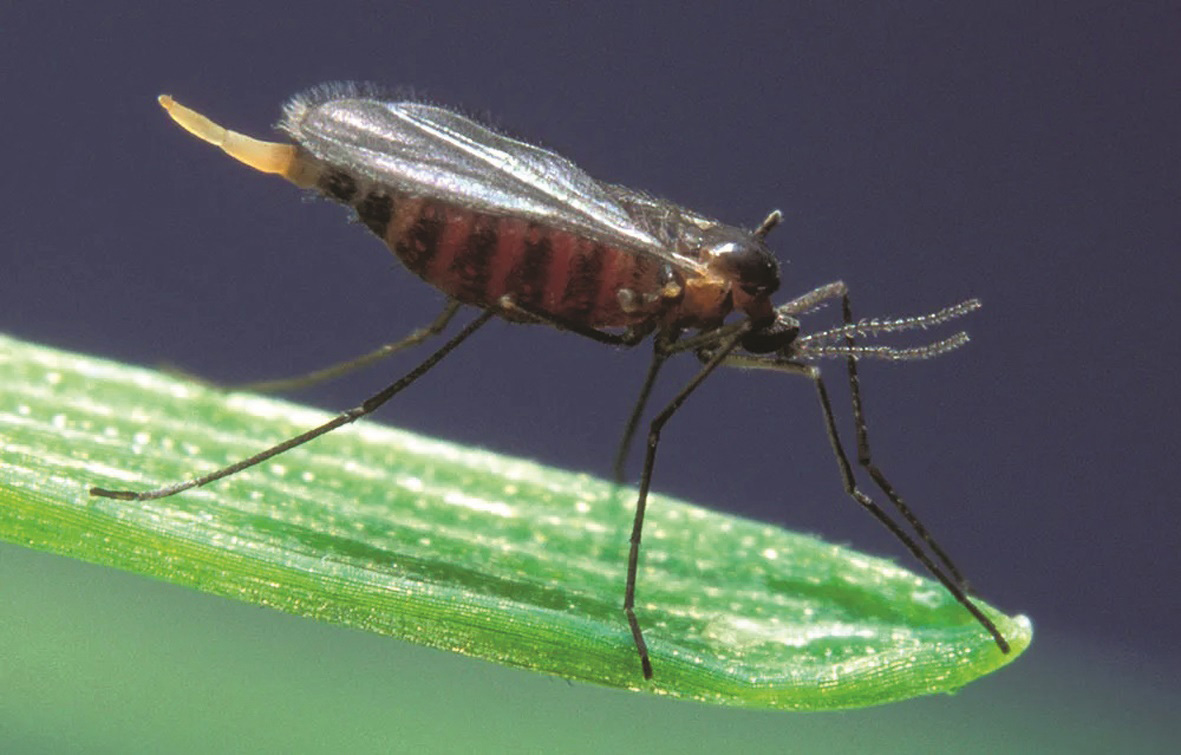
Photo: Scott Bauer
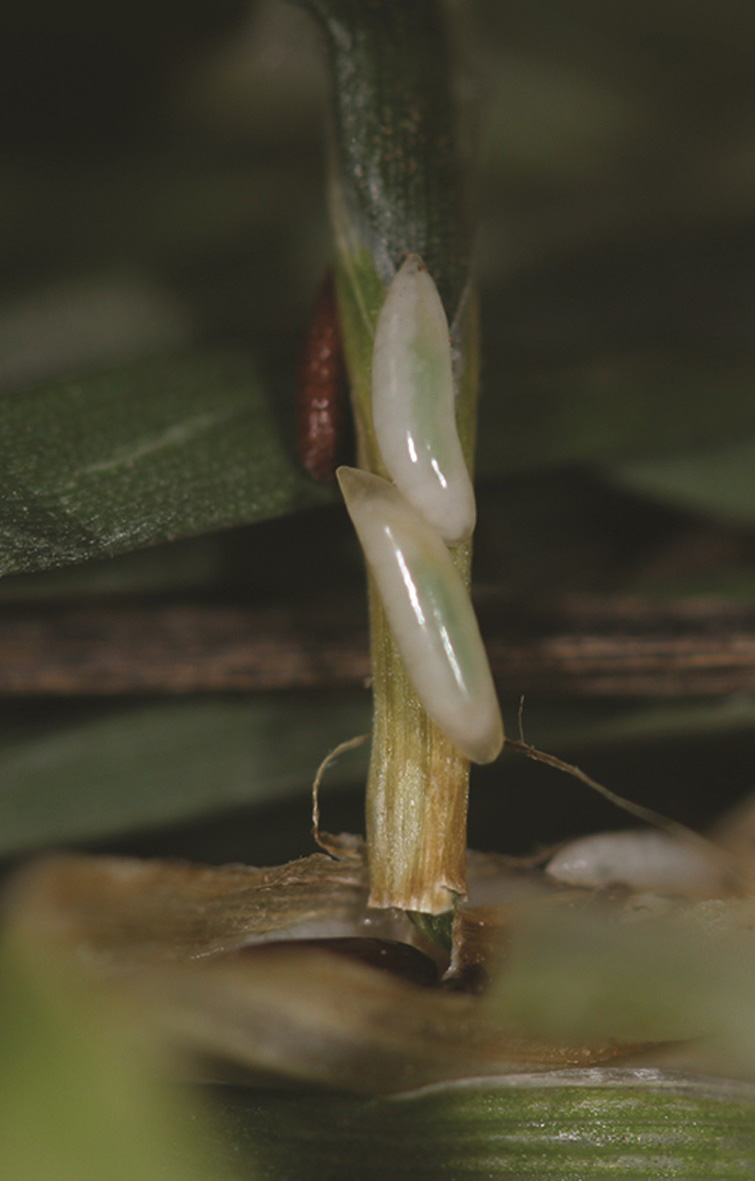
Photo: Jeff Edwards and Tom Royer, Oklahoma State University
Wheat stem sawfly
Particularly problematic in the northeastern USA, annual economic losses associated with this pest can exceed 30%. An egg-laying female uses her saw-like ovipositor to slice an opening into the elongating internode of a wheat stem (generally in a hollow area) and inserts an egg. The larva feeds within the stem until the plant is nearly mature; the duration of this period varies with host plant phenology. Toward the end of the growing season, an obligatory rest known as a diapause is triggered in the insect by two environmental cues. The first cue occurs when host plants are sufficiently mature that visible and infrared light penetrate the stem wall, inducing the larva to move downward to the base of the plant. The second cue occurs when whole plant moisture content drops and the moisture content of the kernels falls to between 41% and 51%, inducing the larva to prepare its hibernaculum.
The larva then cuts a neat V-shaped groove around the entire inside of the stem at ground level, weakening the stem so that it topples easily when wind occurs. The larva plugs the top of the remaining stem with frass, creating a solid plug in the pith cavity that seals the stub after the stem topples. Below the plug the larva encases itself in a silken cocoon and overwinters as a mature fifth instar. As long as the chamber and cocoon remain sealed, the larva is well protected from environmental degradation or predation. Solid-stemmed wheat cultivars that are tolerant of infestation are critical for wheat stem sawfly management, but outbreaks of this pest continue to occur even after six decades of cultivar development. Furthermore, chemical control is not very effective and best results are obtained when resistant cultivars are part of a comprehensive integrated pest management program.
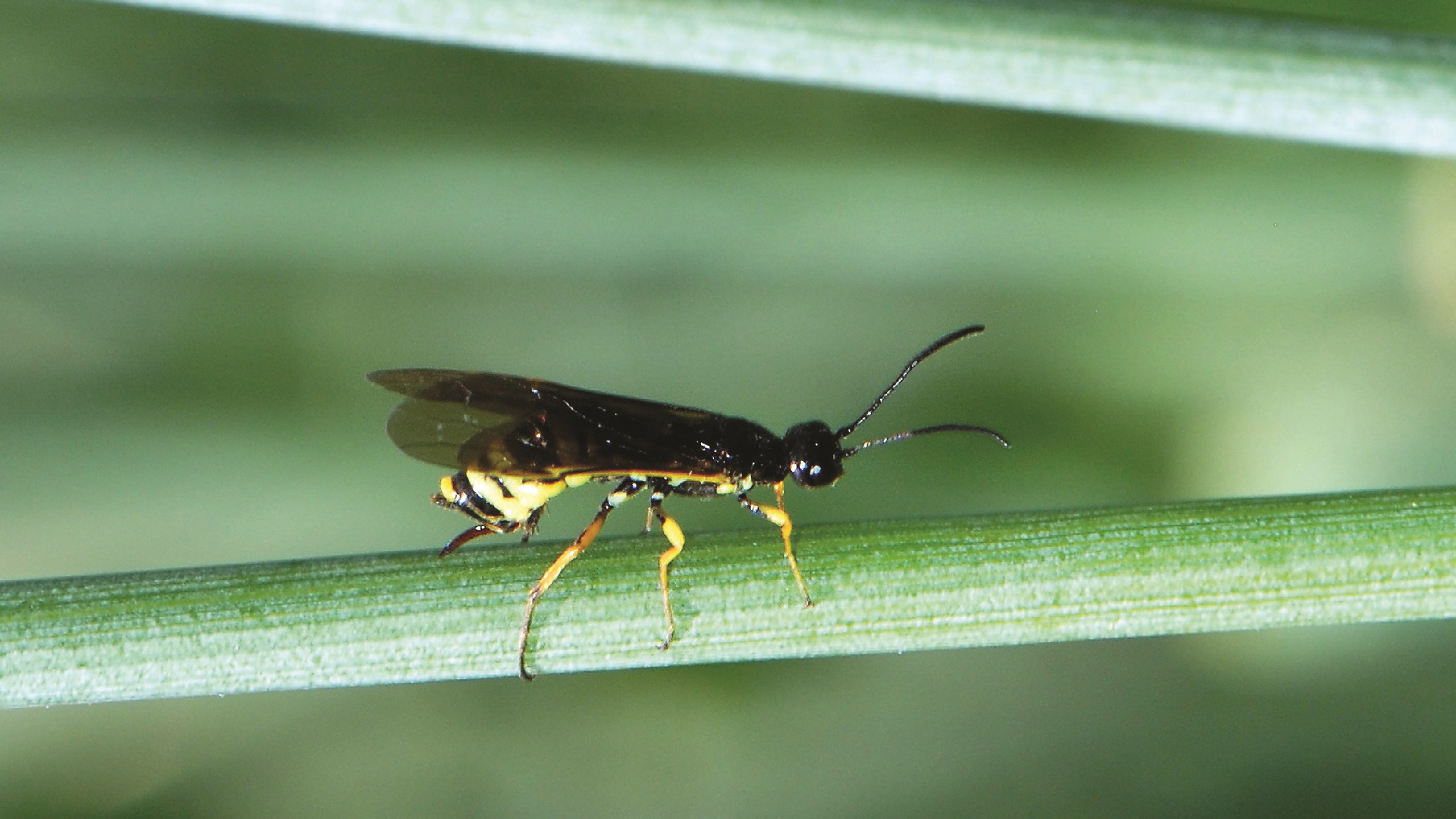
Photo: Patrick Beauzay
Orange wheat blossom midge
This pest occurs in Europe and North America, causing substantial loss by also promoting the spread of pathogenic fungi. In wheat, the susceptible phase starts when the ear emerges from the leaf sheath, and it lasts until the end of flowering. The female of this small orange coloured midge lays her eggs on wheat awns in the evening and early morning. The eggs hatch a few days later, and the midge larvae feed on the surface of newly developing kernels for three to four weeks. When the feeding period is completed, the L3 stage larvae do not moult, but remain in their old skin in a dormant phase until they are triggered by rainfall to drop to the soil and burrow into the soil where they form a cocoon.
Infestation by this pest can significantly reduce harvest yield and grain quality, and can facilitate secondary fungal infections. The kernels may abort entirely, not fully develop, or only be slightly damaged. The extent to which the kernel is damaged largely depends on the number of larvae present as well as when feeding begins relative to the development of the kernel. Smaller, immature seeds are most vulnerable to damage, while the larger more developed kernels are less affected. Concurrently, wheat plants are most susceptible when feeding occurs during early heading and susceptibility declines once flowering is complete. The most obvious impact of this pest is a reduction in yield. However, more subtle effects also occur. Small, shrivelled seed and low test weights are common occurrences and are often mistaken for the effects of frost damage or drought stress.
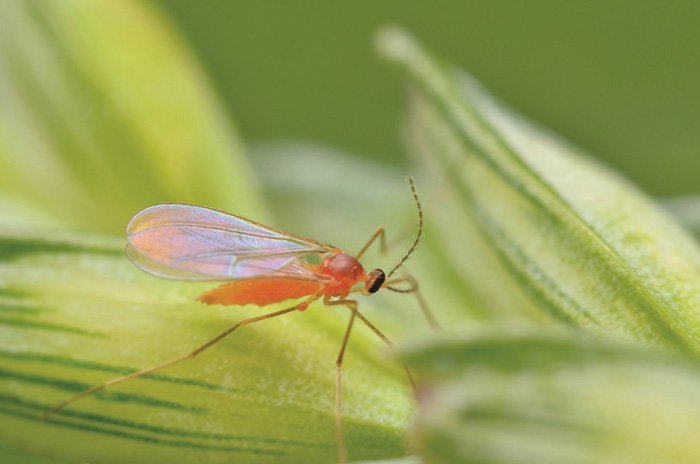
Damage to the seed coat allows easier water entry, often resulting in sprout damage and low falling numbers. In addition, damaged seeds are generally more susceptible to attack from pathogenic fungi, which can reduce germination and seedling vigour and result in dockage due to mould. Furthermore, the adults can act as a vector for diseases that infect wheat seeds (Fusarium head blight and glume blotch). If the emergence of adult midges does not coincide with susceptible growth stages of the host plant, high infestations do not occur. However, this insect can remain dormant in the soil phase for periods ranging from 5 to 13 years.
 South African small-grain producers should take note of these insects and report the occurrence of any of them immediately should they be spotted. It is of utmost importance that as the global population is increasing, South Africa produces as much as possible of its food requirement locally. Experts estimate that by 2050 the world will need one and a half times the amount of wheat currently produced. This projected requirement must be met using the same or fewer hectares of crop land, under more volatile climatic conditions, with cultivars that still have to be developed to deliver these high yields under the predicted circumstances. We should not be caught unawares by invasive alien pests.
South African small-grain producers should take note of these insects and report the occurrence of any of them immediately should they be spotted. It is of utmost importance that as the global population is increasing, South Africa produces as much as possible of its food requirement locally. Experts estimate that by 2050 the world will need one and a half times the amount of wheat currently produced. This projected requirement must be met using the same or fewer hectares of crop land, under more volatile climatic conditions, with cultivars that still have to be developed to deliver these high yields under the predicted circumstances. We should not be caught unawares by invasive alien pests.
Additional resources
- Wheat curl mite colony. Texas A&M https://osuwheat.com/2017/08/11/right-now-is-the-time-to-be-controlling-your-volunteer-wheat-for-wheat-streak-
mosaic// - Wheat curl mite macrograph. M Schiffer, University of Melbourne via Cesar Australia https://cropprotectionnetwork.org/encyclopedia/wheat-streak-mosaic-high-plains-disease-and-triticum-mosaic-of-wheat
- Wheat Streak Mosaic virus (WSMV). M Burrows via United States Land Grant Universities Crop Protection Network https://cropprotectionnetwork.org/encyclopedia/wheat-streak-mosaic-high-plains-disease-and-triticum-mosaic-of-wheat
- Newly hatched Sunn pest nymphs. Mustapha El Bouhssini, ICARDA.
https://repo.mel.cgiar.org/handle/20.500.11766/9110 - Hessian fly adult. Department of Forest and Fisheries, Australia https://www.agriculture.gov.au/biosecurity-trade/pests-diseases-weeds/plant/hessian-flies
- Hessian Fly eggs. University of Nebraska https://extension.okstate.edu/fact-sheets/hessian-fly-management-in-oklahoma-winter-wheat.html
- Hessian Fly larvae and pupa. Jeff Edwards and Tom Royer, Oklahoma State University https://extension.okstate.edu/fact-sheets/hessian-fly-management-in-oklahoma-winter-wheat.html
- Wheat stem sawfly adult. https://agsci.colostate.edu/agbio/wp-content/uploads/sites/127/2022/03/wheat-stem-sawfly.jpeg
- Wheat stem sawfly larvae. Robert KD Peterson, Montana State University https://www.montana.edu/rkdpeterson/wheat-stem-sawfly-related.html
- Wheat stems cut by wheat stem sawfly. https://www.morningagclips.com/wheat-stem-sawfly-infestations-impact-harvest/
- Orange wheat blossom midge adult on wheat awn. https://www.topcropmanager.com/upping-wheats-defences-against-the-big-bad/
- Orange wheat blossom midge larvae feeding on kernels. https://www.topcropmanager.com/upping-wheats-defences-against-the-big-bad/
- Seed damaged by orange wheat blossom midge.
https://agresearch.montana.edu/wtarc/producerinfo/entomology-insect-ecology/OrangeWheatBlossomMidge/MontGuide.pdf



























